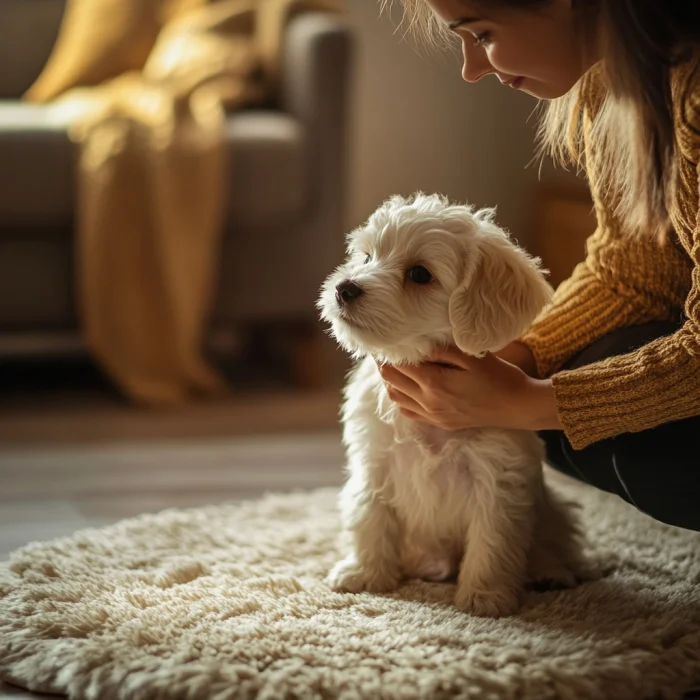Is your puppy crying? Discover why puppies cry and what to do when your puppy cries. Learn how to handle your puppy’s crying and understand their behavior.
What To Do When Your Puppy Cries—and Why He’s Doing It
If you’re a new puppy parent, you’re probably familiar with the unsettling sound of your puppy crying. Whether it’s the middle of the night or when you’re trying to leave the house, puppy crying can tug at your heartstrings. But why does your puppy cry, and what should you do when your puppy cries? Understanding the causes of puppy crying and how to handle it is crucial for both you and your puppy’s well-being. This guide will walk you through everything you need to know about puppy crying, how to soothe your furry friend, and ensure both of you have a peaceful experience together.

Table of Contents
- Why Does My Puppy Cry?
- Understanding the Types of Puppy Crying
- What To Do When Your Puppy Cries
- How to Calm a Crying Puppy at Night
- How To Stop Separation Anxiety Crying
- When Is Puppy Crying a Sign of Something More Serious?
- How to Prevent Future Crying Episodes
- Conclusion
Why Does My Puppy Cry?
Puppies cry for various reasons, ranging from emotional distress to physical discomfort. Understanding why your puppy cries is key to knowing how to address the situation. Here’s a breakdown of some of the most common reasons why puppies cry.
1. Separation Anxiety
Separation anxiety is a common issue that affects many puppies. When left alone, a puppy may cry because they miss their owner and feel insecure. This type of crying is often seen when you leave the house or when your puppy is in a new environment.
2. Hunger or Thirst
Your puppy might cry if they’re hungry or thirsty. Like babies, puppies rely on their owners for nourishment, and if they feel their needs aren’t met, they may vocalize their discomfort.
3. Need for Attention or Affection
Puppies, like people, crave attention and affection. If they feel lonely, they may cry to get your attention. This is especially common if your puppy is adjusting to being away from their littermates.
4. Discomfort or Pain
If your puppy is crying excessively or seems to be in distress, they may be in pain. Teething, illness, or injury can all cause discomfort, leading to crying. It’s important to check for any signs of injury or illness if your puppy’s crying seems unusual.
5. Excitement or Overstimulation
Sometimes, puppies cry out of excitement. Whether it’s playing, meeting new people, or being introduced to new environments, they may express their energy with a high-pitched cry.
Understanding the Types of Puppy Crying
There are different types of crying that may signal different needs or behaviors. By recognizing the type of cry, you can determine the best course of action.
1. Whining Cry
A soft, whining cry typically indicates that your puppy is seeking attention or is unsure about something. This cry usually means they are either bored, lonely, or need some reassurance.
2. Loud Crying or Yelping
If your puppy is yelping or crying loudly, it could be a sign of pain or distress. This type of cry often occurs if the puppy is injured, scared, or overwhelmed.
3. Mournful or Lonely Cry
When your puppy cries in a more mournful way, it often signals loneliness or a desire for your presence. This cry is common when your puppy is left alone, especially during the night.
4. Teething Crying
If your puppy is teething, they may cry because their gums hurt. This is a temporary phase, but it can be uncomfortable for them.
What To Do When Your Puppy Cries
Now that you understand the reasons behind your puppy’s crying, it’s important to know how to respond. Here are some helpful strategies on what to do when your puppy cries:
1. Respond with Calm and Reassurance
When your puppy cries, it’s important to remain calm and reassuring. Puppies are sensitive to your emotions, so if you become stressed, your puppy might pick up on that. Offer a gentle voice and some comforting words.
2. Ensure Their Basic Needs Are Met
Check to make sure your puppy’s basic needs are being met. Does your puppy have access to fresh water? Is their food bowl empty? Make sure they are comfortable and have everything they need before considering other causes for the crying.
3. Provide Comfort and Security
If your puppy is feeling lonely or insecure, offering comfort can help. You can use a soft blanket or a comforting toy to help them feel secure. Sometimes, having a piece of your clothing with your scent can provide reassurance to your puppy.
4. Create a Cozy Sleeping Area
For puppies that cry at night, providing a cozy, safe sleeping area is crucial. A crate can provide a den-like space where your puppy feels safe and secure, which can reduce crying.
5. Don’t Reward Crying for Attention
It’s important not to inadvertently reward your puppy for crying for attention. While it’s hard to ignore their cries, responding every time they cry for attention can reinforce this behavior. Instead, wait for a moment of quiet before offering affection.
How to Calm a Crying Puppy at Night
Nighttime crying is a common issue that many puppy owners face. Puppies are adjusting to being separated from their littermates and may feel anxious in the dark. Here are some tips on how to calm your crying puppy at night:
1. Nighttime Routine
Establishing a consistent bedtime routine can help your puppy feel more comfortable. Puppies thrive on routine, so feeding, potty breaks, and bedtime should occur at the same time every night.
2. Provide a Nightlight
A soft nightlight can offer comfort to your puppy. The light may help ease their fear of the dark and reduce nighttime anxiety.
3. Consider a Crate
Crating your puppy at night can help them feel more secure. Make the crate a positive, cozy space by placing a soft bed inside and keeping it in a quiet area of your home.
4. Comforting Sounds
Some puppies respond well to soothing sounds, such as white noise or soft music. This can drown out outside noises that might be causing distress.
How To Stop Separation Anxiety Crying
Separation anxiety can be a major cause of puppy crying. If your puppy has trouble being alone, here’s what you can do to reduce their anxiety:
1. Gradual Alone Time Training
Start by leaving your puppy alone for short periods and gradually increase the duration. This helps your puppy get used to being alone without feeling abandoned.
2. Interactive Toys
Give your puppy interactive toys that can keep them occupied while you’re away. Puzzle toys, treat-dispensing toys, and chew toys can provide distraction and reduce anxiety.
3. Leave Comfort Items Behind
Leave something with your scent, like a shirt or blanket, to comfort your puppy while you’re gone.
When Is Puppy Crying a Sign of Something More Serious?
While most puppy crying is due to common issues like hunger or separation anxiety, there are times when it might indicate a more serious problem. Watch for signs of injury, illness, or severe distress.
1. Signs of Injury
If your puppy is crying excessively and seems to be avoiding movement, they may be injured. Check for any signs of visible wounds or limping, and contact your vet if necessary.
2. Persistent Crying with No Relief
If your puppy continues crying despite addressing their basic needs, and the crying persists, it could be a sign of illness. Watch for changes in appetite, energy levels, or behavior, and consult your veterinarian if you suspect something is wrong.
How to Prevent Future Crying Episodes
Once you’ve addressed your puppy’s immediate crying needs, here are some strategies to help prevent future crying episodes:
1. Training and Socialization
Start training and socializing your puppy early on. The more experiences your puppy has, the less likely they are to cry out of fear or confusion.
2. Provide Regular Playtime
Make sure your puppy is getting enough physical and mental exercise. Boredom can lead to crying, so regular playtime is essential for their well-being.
3. Establish a Routine
A predictable routine helps your puppy feel secure. Consistency in feeding, playtime, and sleep will help reduce anxiety and crying.
Conclusion
Puppy crying is a normal part of the adjustment period, but understanding why your puppy is crying and knowing how to respond can help both of you navigate this phase more smoothly. By meeting your puppy’s needs, providing comfort, and addressing any underlying issues, you’ll foster a sense of security and reduce the crying over time. Remember, patience and consistency are key!
For more pets related articles click here https://ledstk.com/category/pets/ and for recipe lovers see here sotastyrecipe.com
